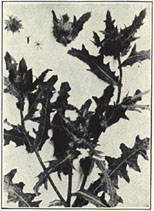Blessed Thistle. Cnicus benedictus L.
Description
This section is from the "The Herb Hunters Guide" book, by A. F. Sievers. Also available from Amazon: Herb Hunters Guide.
Blessed Thistle. Cnicus benedictus L.

Figure 20.—Blessed thistle (Cnicus benedictus)
Synonyms
Carduus benedictus Steud., Carbenia benedicta Adans.
Other Common Names
Holy thistle, St.-Benedict's-thistle, Our Lady's thistle, bitter thistle, spotted thistle, cursed thistle, blessed cardus, spotted cardus.
Habitat And Range
The blessed thistle is a weed which is found sparingly in waste places and stony, uncultivated localities from Nova Scotia to Maryland and the Southern States, also on the Pacific coast.
Description
This plant, which scarcely exceeds 2 feet in height, has a coarse, erect, branched, and rather woolly stem. The leaves are 3 to 6 inches long, more or less hairy, with margins lobed and spiny. The yellow flower heads which appear from about May to August are borne at the ends of the branches, almost hidden by the upper leaves, and are about 1 1/2 inches long. Surrounding the flower heads are leathery scales, tipped with long, branching, yellowish-red spines. The herb has a rather disagreeable odor which is lost in drying.
Part Used
The leaves and leafy flowering tops, gathered preferably just before or during the flowering period.
Continue to:


